 Browns Archive
Browns Archive  From Best to Bust: Top-Five QBs Since 1978
From Best to Bust: Top-Five QBs Since 1978
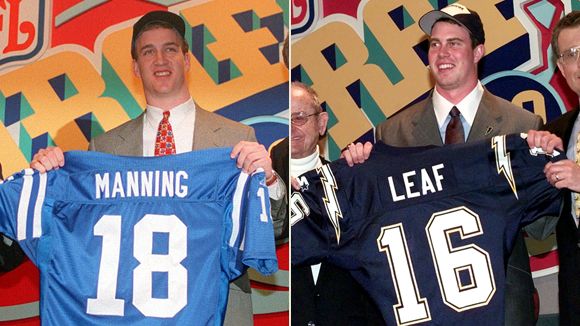 “The bust rate for first-round quarterbacks is higher than for any other position.”
“The bust rate for first-round quarterbacks is higher than for any other position.”
We hear that phrase on radio shows and read it on message boards, mainly as an argument against the Browns investing a high first-round selection on a quarterback. There’s too much risk, it’s said, for a team with little overall talent to gamble on a quarterback with a premium pick.
But is it true? Is the bust rate of first-round quarterbacks prohibitively high? Let’s find out.
Since 1978- the year the regular-season schedule was lengthened to sixteen games and the new rules were established to facilitate the passing game- thirty-one quarterbacks have been taken with one of the top five selections in the NFL Draft. That’s an average of less than one per year; exclusive company.
I’ve gone through every one of these thirty-one quarterbacks and divided them into six categories: Best of the Best (current or certain Hall-of-Famers); Outstanding (not quite Hall-of-Famers but guys who vindicated their high selections with excellent play for several years); Solid (players who flashed brilliance but were dogged by injuries, inconsistency or postseason failures); Ciphers (players who bloomed late in organizations other than the ones that drafted them); Underachievers (players who started, stayed in the league for several years but never met their draft-day expectations); and Busts (guys who washed out completely after a few years of dismal play.)
Best of the Best (3)
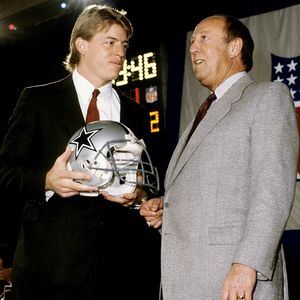 John Elway (#1, 1983): It took two first-round picks to wrest Elway away from the Baltimore Colts, but it was an investment the Broncos never regretted. In sixteen seasons in Denver Elway led the Broncos to five Super Bowls and helped win the only two World Championships in franchise history. His career numbers are surprisingly pedestrian- a 56.1 completion percentage, 79.9 career rating and 226 interceptions- but the numbers fail to do justice to the physical gifts, the leadership or the clutch play that made Elway a legend. There are quarterbacks with more impressive numbers, but no one was scarier with the ball in his hands and the game on the line.
John Elway (#1, 1983): It took two first-round picks to wrest Elway away from the Baltimore Colts, but it was an investment the Broncos never regretted. In sixteen seasons in Denver Elway led the Broncos to five Super Bowls and helped win the only two World Championships in franchise history. His career numbers are surprisingly pedestrian- a 56.1 completion percentage, 79.9 career rating and 226 interceptions- but the numbers fail to do justice to the physical gifts, the leadership or the clutch play that made Elway a legend. There are quarterbacks with more impressive numbers, but no one was scarier with the ball in his hands and the game on the line.
Troy Aikman (#1, 1989): As a quarterback Aikman is in the same category as Bart Starr and Bob Griese- guys who didn’t necessarily carry their teams but were accurate, calculating; capable of making the big play and, most of all, winners. Aikman won three Super Bowls as a Cowboy, and although he spent much of that era handing off to Emmitt Smith he could and did shine when the lights were on. During Dallas’s first title run in 1992, Aikman completed 68.5 percent of his passes with eight touchdowns and no interceptions in the playoffs and outplayed Steve Young at Candlestick Park in the NFC Championship Game.
Peyton Manning (#1, 1998): Prior to Manning’s arrival the Colts hadn’t won more than nine games in a season since they played in Baltimore two decades earlier. After his arrival they won ten or more eleven times and averaged twelve wins per year from 2002 through 2010, a span that included two Super Bowl appearances and the franchise’s first World Championship since 1970. Manning is third on the career passing yardage and career touchdown passes lists and in 2004 broke an NFL record (since eclipsed by Tom Brady) with 49 scoring tosses.
Outstanding (7)
Drew Bledsoe (#1, 1993): Bledsoe had his weaknesses- he was a 57.2-percent career passer, not stellar for his era, and he threw a lot of interceptions; 206 total,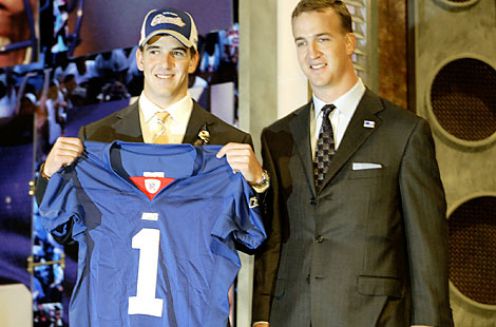 including a league-leading 27 in 1994. But he topped the 4,000-yard mark in three seasons, reached three Pro Bowls and was a key figure in the first stages of New England’s rise from laughingstock to perennial Super Bowl contender. Bledsoe did a by-and-large admirable job as a franchise quarterback for the Patriots, and he was worth the top overall pick they spent on him.
including a league-leading 27 in 1994. But he topped the 4,000-yard mark in three seasons, reached three Pro Bowls and was a key figure in the first stages of New England’s rise from laughingstock to perennial Super Bowl contender. Bledsoe did a by-and-large admirable job as a franchise quarterback for the Patriots, and he was worth the top overall pick they spent on him.
Steve McNair (#3, 1995): Coming out of tiny Alcorn State, the late McNair wasn’t the most polished passer the league has ever seen. But he was certainly adequate throwing the ball, especially in conjunction with his running ability. In addition to completing 60.1 percent of his passes with a 174-119 touchdown-to-interception ratio, McNair ran for 3,590 yards and 37 touchdowns, averaging 5.4 yards per carry. He also helped win a lot of games, leading teams to double-digit victories in four different seasons and taking the Titans to their first Super Bowl in 1999. 632-1068
Donovan McNabb (#2, 1999): One of the few successful members of the heralded quarterback Class of ’99, McNabb helped transform the Eagles from perennial losers to perennial winners. The six-time Pro Bowler had his best season in 2004, throwing 31 touchdown passes and compiling a 104.7 rating as Philadelphia reached the Super Bowl for the first time in nearly a quarter-century. Like McNair, McNabb was an excellent runner, with 3,459 yards and 29 touchdowns on the ground. Criticized for accuracy and leadership issues, McNabb still has to be considered an overall success as a high pick.
Eli Manning (#1, 2004): With two Super Bowl wins and more road playoff wins than any quarterback in league history, Eli arguably belongs in the top tier. He inarguably was great this past season when he threw for 4,933 yards at 8.4 yards per attempt with 29 touchdowns and outdueled Aaron Rodgers and Tom Brady in the postseason. And he isn’t a one-year wonder- he’s raised his game over the last three or four years, although he did lead the NFL in interceptions in 2010. Picks, inaccuracy and inconsistency were issues with Eli, who up until recently was good for at least one horrible game per season.
Phillip Rivers (#4, 2004): Rivers can be criticized for not getting the Chargers to the Super Bowl, but in terms of consistency he’s certainly filled the bill, with 96 straight starts and four straight 4,000-yard seasons. He’s accurate, has thrown twice as many touchdowns as interceptions and has led the NFL in both yards and touchdowns. San Diego has had its ups and downs, but they’ve stayed in contention throughout Rivers’ career.
Matthew Stafford (#1, 2009): He’s only been in Detroit for three years, but Stafford’s effect on the Lions has already been monumental. The gunslinger from Georgia has become Detroit’s first true franchise quarterback in more than fifty years, and his spectacular 2011 season- 5,038 yards, 41 touchdowns- helped lead the Lions to their first winning season in over a decade. Ever since the days of Bobby Layne the Lions have looked for the Guy under center, and hadn’t found one. In Matt Stafford, they’ve found one now.
Cam Newton (#1, 2011): If the rest of Newton’s career is as productive as his first season, there will be no question about his inclusion in this group. The Heisman winner from Auburn completed 60.1 percent of his passes for a rookie record 4,051 yards and added 14 touchdowns on the ground, a single-season record for quarterbacks. All he has to do at this point is keep up the personal pace and add some wins for the Panthers, who went 6-10 in 2011.
Solid (6)
Jim McMahon (#5, 1982): In some respects the Punky QB belongs in the “Outstanding” group. He was the winning quarterback in Super Bowl XX and played very 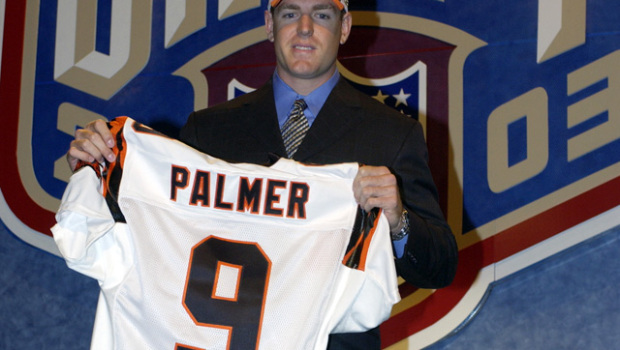 well in that game, throwing for 256 yards. McMahon was one of the inspirational leaders of the great Bears teams of the ‘80s and he was a winner, triumphing in 69 percent of his career starts. But McMahon was was always hurt; he never started every game in a season and his yearly injuries were a major factor in Chicago’s failure to get back to the Super Bowl after 1985. McMahon never threw for more than 2,392 yards or more than 15 touchdowns in a season and was pretty much kaput as a regular by his thirties. Undersized and absolutely fearless- a bad combination- he wound up as more a pop culture icon than a great NFL quarterback.
well in that game, throwing for 256 yards. McMahon was one of the inspirational leaders of the great Bears teams of the ‘80s and he was a winner, triumphing in 69 percent of his career starts. But McMahon was was always hurt; he never started every game in a season and his yearly injuries were a major factor in Chicago’s failure to get back to the Super Bowl after 1985. McMahon never threw for more than 2,392 yards or more than 15 touchdowns in a season and was pretty much kaput as a regular by his thirties. Undersized and absolutely fearless- a bad combination- he wound up as more a pop culture icon than a great NFL quarterback.
Jim Everett (#3, 1986): Everett actually had a couple of very good years with the Rams, leading the league in touchdown passes in both 1988 and ‘89. But he had a short prime, threw a lot of interceptions without a great completion percentage- kind of a poor man’s Drew Bledsoe in that regard- and never seemed to recover psychologically from his beating at the hands of the 49ers in the 1989 NFC title game. Everett’s won-loss record in his last 104 starts following that San Francisco game was 34-70. To a certain extent Everett was caught up in the organizational-wide collapse the Rams suffered in their final years in Los Angeles. Still- when you’re known more for an on-air confrontation with a sports talk-show host than for what you did on the football field, that can’t be good.
Michael Vick (#1, 2001): Vick was a revolutionary figure in re-introducing running ability- not scrambling ability, but running ability- to the pro quarterback’s arsenal. At 5,219 yards he holds the career rushing record for quarterbacks; has averaged 7.2 yards per carry and in 2006 became the first quarterback to rush for 1,000 yards in a season. As a passer he’s been less successful, only completing 60 percent of his attempts once. He’s had numerous injuries due to his playing style and spent two of what should have been prime seasons in a federal prison on dogfighting charges. As an electrifying playmaker he’s been everything he was projected to be coming out of Virginia Tech; the substance of a great sustained career, however, hasn’t been there.
Carson Palmer (#1, 2003): Palmer reversed the trend of Bengals first-round busts at quarterback and brought the Cincinnati franchise to levels not seen since the days of Sam Wyche and Boomer Esiason. In 2005 he led the NFL in touchdown passes and completion percentage, compiled a rating of 101.1 and guided the Bengals to the postseason for the first time since 1990. He’s never been the same since tearing up his knee early in the playoff loss to Pittsburgh that year, but in terms of being a franchise quarterback he’s done fairly well, especially considering he’s spent most of his career in Cincinnati, not exactly the model NFL organization.
Alex Smith (#1, 2004): After six uneven seasons the light came on for Alex Smith in 2011; starting all sixteen games for the first time in his career, Smith threw for 17 touchdowns with only five interceptions and amassed a rating of 90.7 as the 49ers reached the NFC Championship Game. Actually Smith has been trending upward for a couple of years- he threw 32 touchdowns to 22 picks with a rating of over 80 in 2009 and ’10- but 2011 was the first season he was fully healthy and the unquestioned man under center in San Francisco. At this point he’s still somewhat of a one-year wonder.
Matt Ryan (#3, 2008): Prior to the arrival of Matty Ice the Falcons had played 42 seasons without ever putting up back-to-back winning records. Since his arrival they’ve never had a losing season and have made the playoffs three times. Ryan has the regular-season wins and the regular-season numbers- a 43-19 record as a starter, an 88.4 career rating and a 95-to-46 touchdown-to-interception ratio. He’s yet to win a playoff game, however, and hasn’t played well in any of Atlanta’s three postseason losses during his career.
Ciphers (3)
Vinny Testaverde (#1, 1987): Had Vinny’s entire career gone the way of his first few years in Tampa Bay he’d be remembered as an all-time bust. In his second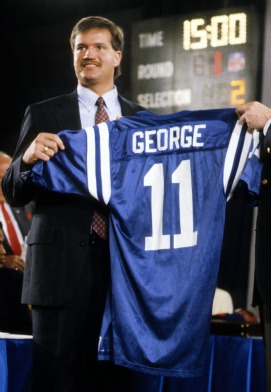 season the Heisman winner from Miami completed 47 percent of his passes and threw 35 interceptions, second-most in pro football history. Later on, however, Vinny matured into a capable starter with the gifts to flash brilliance. He led two different teams to playoff victories and had a career year in 1998, when he threw 29 touchdown passes to seven picks with a rating of 101.6, went 12-1 as a starter and led the Jets to within thirty minutes of a Super Bowl. He never quite got past the interception bug- he threw 267, fourth all-time- but during Vinny’s prime you could win with him.
season the Heisman winner from Miami completed 47 percent of his passes and threw 35 interceptions, second-most in pro football history. Later on, however, Vinny matured into a capable starter with the gifts to flash brilliance. He led two different teams to playoff victories and had a career year in 1998, when he threw 29 touchdown passes to seven picks with a rating of 101.6, went 12-1 as a starter and led the Jets to within thirty minutes of a Super Bowl. He never quite got past the interception bug- he threw 267, fourth all-time- but during Vinny’s prime you could win with him.
Jeff George (#1, 1990): Jeff George was a great talent and just as great an enigma. Although capable of sustained production, he sabotaged himself with a standoffish personality that melted welcome mats underneath his feet. George played for five different NFL teams, and all five tenures ended in exits that were acrimonious to be kind. Indianapolis fans would call him an out-and-out bust: the Colts traded Andre Rison, Chris Hinton and a first-round pick for his draft rights and got a 14-35 record as a starter out of the deal. George never found traction at any of his stops after that.
Kerry Collins (#5, 1995): Like Jeff George, Collins was a mixed bag. He helped Panthers reach the NFC Championship Game in his second season, but he drank his way out of Carolina, flopped in New Orleans and looked washed up at 26. Unlike George, however, Collins found a home. Clean and sober, the former Penn State All-American enjoyed several solid seasons in New York, leading the Giants to the Super Bowl in 2000. He found a third act in Tennessee as a game-manager for some solid Titans teams in the late 2000’s. Collins’s career got off to a rough start but he bounced back to become a productive and durable player, the last member of the Draft Class of 1995 to hang ‘em up.
Underachievers (7)
Jack Thompson (#3, 1979): The Throwin’ Samoan spent six seasons in the NFL but never didn’t put up impressive numbers and didn’t win games- his career record as a starter was a dismal 4-17. After serving as Ken Anderson’s understudy in Cincinnati, Thompson got his shot as a regular in Tampa Bay in 1983. But he didn’t fare well, throwing 21 interceptions as the Buccaneers limped to the worst record in the league. Two years later the Throwin’ Samoan was out of football.
Rick Mirer (#2, 1993): The former Notre Dame star actually outplayed Drew Bledsoe, the man taken in front of him, as a rookie with the Seahawks in 1993. But Mirer, a mobile quarterback who had played in a ground-oriented attack in college, never grasped the intricacies of NFL passing offenses. Inaccurate and mistake-prone throughout, Mirer completed only 53.3 percent of his attempts and threw 76 interceptions to 50 touchdown passes in an eight-year career spent with five different teams.
Tim Couch (#1, 1999): Couch’s saga is obviously well-known, so no sense in getting into it here. I’ll just say, not for the first time, that Couch wasn’t that bad of a quarterback. His ceiling might not have been particularly high- Alex Smith, probably- but he wouldn’t have gotten in the way of an 11-5 season. Courtney Brown was a bigger bust, as far as I’m concerned. He didn’t even look like he gave a shit.
David Carr (#1, 2002): Carr was the first overall pick and Opening Day starter for the expansion Houston Texans. As a rookie he was sacked an NFL-record 76 times (he would be sacked 68 times in 2005, third all-time.) Although he led the league in completion percentage in 2006 and twice topped an 80 rating, he never threw more than 16 touchdown passes in a season and produced a dismal 22-53 record in Houston. In 2007 the Texans cut Carr loose, replacing him with Matt Schaub, and the former number-one pick saw his career peter out as a backup for the Panthers, 49ers and Giants. It can’t be said for sure if David Carr failed because of his supporting cast, because of David Carr, or a little bit of both. Whatever the reason, he never lived up to the hype.
Joey Harrington (#3, 2002): Taken two spots behind Carr in the ’02 Draft, Joey Harrington didn’t work out any better than his counterpart in Houston. The one-time Oregon Duck threw 79 touchdown passes and 85 interceptions for his career, averaged a dismal 5.8 yards per attempt and compiled a 26-50 record as a starter. It’s easy to blame the Lions organization for his failure, but Joey Harrington was probably just one of those players who wouldn’t have made an impact regardless of who drafted him. He lacked overwhelming talent, wasn’t much of a leader and just didn’t seem to have the physical or mental makeup to be a true franchise guy.
Vince Young (#3, 2006): Winning NFL games have never been an issue for Vince Young, who has a 31-19 career record as a starter. It’s been everything else: his accuracy (57.9 percent), his lack of production (46 career touchdown passes, as many as Drew Brees threw just last season) and his mental makeup, all of which drove the Titans to replace him with an aging Kerry Collins as the starter in 2008. Young has always been a good runner- he rushed for 552 yards and seven scores as a rookie- but doesn’t seem to have the passing chops or the mental toughness to be a top-flight regular.
Mark Sanchez (#5, 2009): It’s tough to step into a better cockpit than the one Sanchez stepped into in 2009; a veteran team with a stingy defense, a talented offensive line and a solid array of skill players. But despite helping the Jets reach back-to-back AFC title games, the former USC Trojan has been unimpressive in terms of individual performance. Sanchez’s 73.2 passer rating is actually lower than that of Tim Couch in his first three seasons and his 55.4 percent career completion percentage is well below what you’d want out of a franchise passer. He took some heat from his teammates in the wake of New York’s late collapse in 2011 and there’s even been some talk of the Jets giving up on Sanchez altogether and making a bid for Peyton Manning. There’s time for a turnaround- Eli Manning certainly made one- but as of now the Sanchize smells like a bust.
Sam Bradford (#1, 2010): Bradford showed some promise as a rookie, completing 60 percent of his passes for 3,512 yards and 18 touchdowns as the Rams finished a surprising 7-9. But he regressed badly in 2011, completing just 53.5 percent and throwing a scant six touchdowns in ten starts. To be sure, Bradford’s supporting cast isn’t very good; the offensive line is porous and the receiving corps might be the worst in football. But he hasn’t exactly raised the play of the guys around him and his six-yards-per-attempt career figure is pitiful. There are some mitigating factors and it’s still early, but Bradford has yet to justify the investment St. Louis has made in him.
Busts (5)
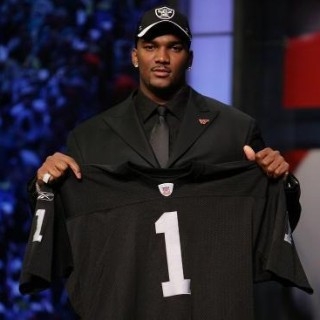 Art Schlichter (#4, 1982): It’s impossible to say whether or not Schlichter had the physical tools required of a great NFL quarterback because he annihilated his career, not to mention his life, with his gambling addiction. What we can say is that Schlichter’s three-year career produced a grand total of three touchdown passes. What’s more, his fiasco set the stage for another
Art Schlichter (#4, 1982): It’s impossible to say whether or not Schlichter had the physical tools required of a great NFL quarterback because he annihilated his career, not to mention his life, with his gambling addiction. What we can say is that Schlichter’s three-year career produced a grand total of three touchdown passes. What’s more, his fiasco set the stage for another
Heath Shuler (#3, 1994): The Congressman (D-Tenn.) didn’t have the personal problems that pop up throughout the list of bottom feeders. He just wasn’t very good. In four seasons with the Redskins and Saints, Shuler completed 49.2 percent of his passes with 15 touchdowns and 33 interceptions- poor numbers in any era. A foot injury slammed the door on his career in 1997, but that was just as well- a decade later Shuler would return to Washington D.C. as a United States Congressman.
Ryan Leaf (#2, 1998): Once upon a time there were people who thought Ryan Leaf would be a better pro than Peyton Manning. (I was one of them, actually.) That was before Leaf played a down, of course. Eventually he did- and it was all downhill from there. In three years with the Chargers, Leaf alienated the media, the fans, his teammates and his bosses, completed 48 percent of his passes with 13 touchdowns and 33 interceptions, went 4-14 as a starter and became by almost universal acclaim the biggest bust in the history of the Draft. Worst of all was what San Diego gave up to move up one spot in the draft for Leaf: two first-round picks and a second-round pick, as well as Eric Metcalf.
Akili Smith (#3, 1999): He probably had no business being selected with the third overall pick in ’99 but Cincinnati went ahead and drafted Akili Smith anyway, undeterred by the 12 he scored the first time he took the Wonderlic. The combination of raw skills, low IQ and the poor organization that drafted Smith proved lethal. Smith threw five touchdown passes in his four years with the Bengals. As it turned out, they’d spent a top-three pick on a guy who probably wouldn’t have been even a serviceable NFL quarterback under any circumstance.
Jamarcus Russell (#1, 2007): Even by latter-day Raider standards this pick was a disaster. Physically, mechanically and otherwise, Russell never came close to justifying his selection. In three seasons in black-and-silver the former LSU star completed 52.1 percent of his passes, threw 18 touchdowns and 23 interceptions and amassed a rating of 65.2. A multitude of on and off-the-field problems washed him out of football before his 25th birthday.
*****
By my count there are a total of sixteen quarterbacks in the Best-of-the-Best, Outstanding and Solid Categories and fifteen in the Cipher, Underachiever and Bust category. So there’s a slightly better than 50 percent chance that a team which drafts a quarterback in the top five will get some kind of positive return on its investment.
Is that really a lower percentage than for, say, offensive tackles? It’s hard to say without doing a similar survey of that position. But for all the talk about how taking a tackle is the “safer” strategy there have been a number of high-profile busts at that position as well: Jason Smith, Robert Gallery, Tony Mandarich and Chris Ward, as well as several others (Antone Davis, Charles McRae, Brian Jozwiak) taken just outside the top five.
This year the Browns may have an opportunity to spend a top-five pick on a quarterback, likely Baylor’s Robert Griffin III. Hopefully they won’t be dissuaded by the “bust rate” at the position and will go get their franchise guy if he’s available. Maybe the Browns can’t afford to fail; but they also can’t be afraid to fail.
- NBA Announces 2013-2014 Schedule
- Browns Ink Sharknado
- Sharknado A No-Show For Rookie Camp
- Trent Richardson Out Until Training Camp
- Browns Sign Brandon Jackson
- Carrasco Suspended Eight Games
- Browns Add to Wide Receiver Depth with David Nelson
- Browns Need to Learn from Past Draft Mistakes
- Browns Release Chris Gocong and Usama Young
- Browns Missing on Grimes Disappointing, But Not The End
The TCF Forums
- Official- Browns Coach Search/Rumors
Hikohadon (Tuesday, January 21 2014 1:24 PM) - Movies coming out
rebelwithoutaclue (Tuesday, January 21 2014 12:56 PM) - 2015 Recruiting
jclvd_23 (Tuesday, January 21 2014 12:38 PM) - The 2014 Offseason Thread
Larvell Blanks (Tuesday, January 21 2014 12:25 PM) - Chris Grant's first 3 drafts
Kingpin74 (Tuesday, January 21 2014 10:13 AM) - Mike Brown
YahooFanChicago (Monday, January 20 2014 11:15 PM) - 2014 Hoops Hockey Hijinx
jpd1224 (Monday, January 20 2014 4:44 PM) - 2014 Recruiting
jclvd_23 (Monday, January 20 2014 2:26 PM) - Wish List - #4 Pick
Hikohadon (Monday, January 20 2014 1:26 PM) - #1 overall pick Anthony Bennett
TouchEmAllTime (Sunday, January 19 2014 1:28 PM)


